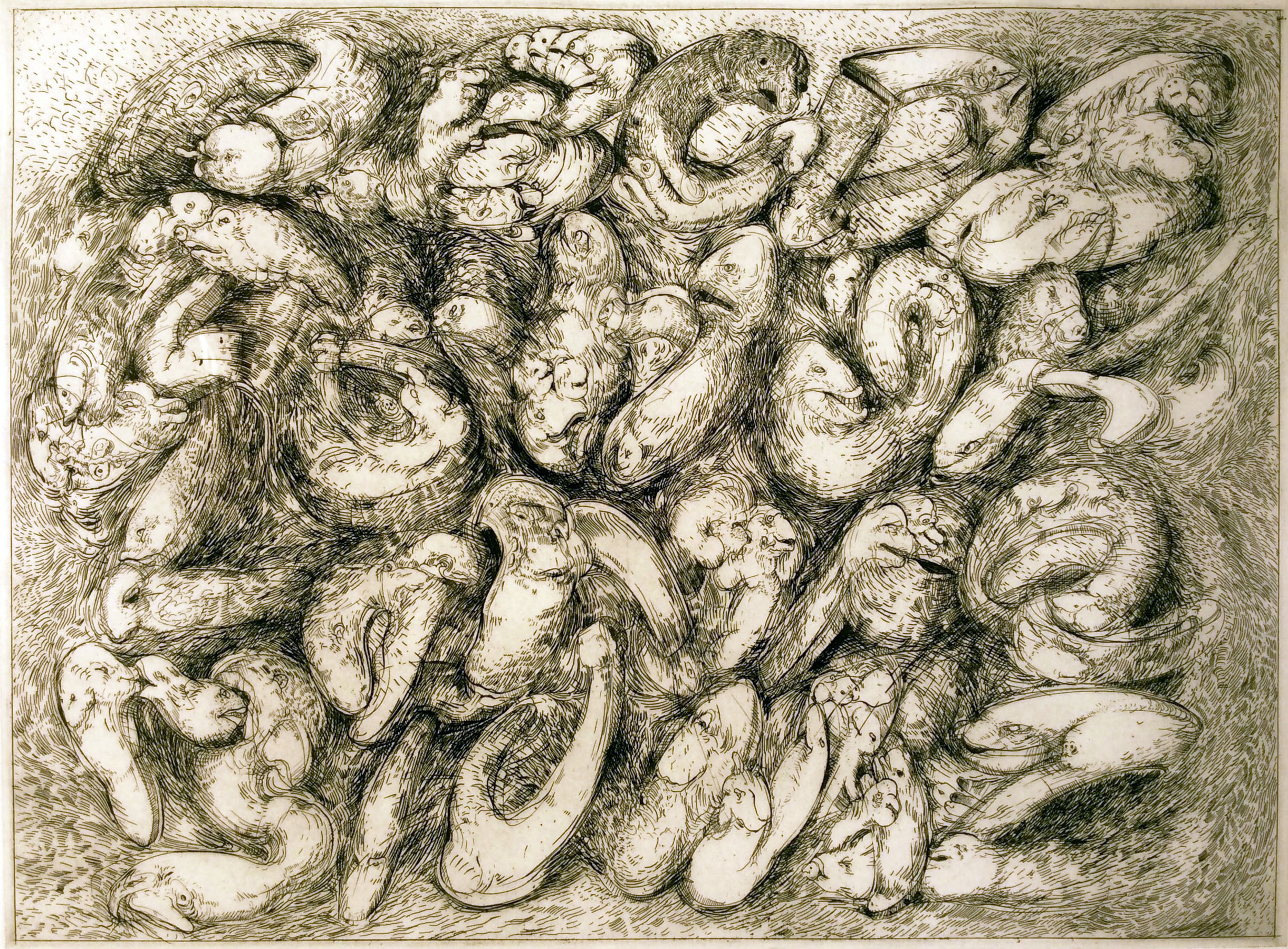- Michael Miller: Art Commentary by Gregg Hertzlieb
Michael Miller (1938-2014)
Alphabet, 1975
Etching on paper, 19/50, paper: 19 x 23 inches, image: 11 ½ x 15 ½ inches
Promised Gift to the Brauer Museum from An Anonymous Donor
Michael Miller was for many years a professor of printmaking at the School of the Art Institute of Chicago. His style involved a complex relationship between direct and indirect references to print history and quotations from the broad field of commercial illustration and graphic art. While he strove throughout his career to develop and use innovative techniques to expand the boundaries and conceptions of what an original print can be, he also frequently used traditional methods to create prints that demonstrate a remarkable mastery of the various processes. Alphabet is an early work by the artist, full of movement and energy, that brings smiles to the faces of all who see it.
In Alphabet, vaguely mammalian creatures writhe and twist and contort themselves into letters of the alphabet in a print that nicely shows Miller’s sense of humor and spirit of invention. His prints before this one chronicled the ascent of primordial beings as they crawled out of the raging seas onto land to begin their transitions into land dwellers. Here, the life forms assume a pattern, a tableau, where beasties must assume the roles of and configure themselves into the various letters. The matrix into which they fit themselves is artificial, but their internal tasks within that matrix enable viewers to look past the letter shapes to investigate their actions and positions.
The etching involves just one plate of black line work printed on the sheet. Miller’s skill in inking and wiping a plate of this size is evident, with the line work fluid, animated, and rich throughout the image. Through careful yet lively line activity, he creates a scene bustling with organic action, even as a squint on the viewer’s part brings the alphabet into visibility. The print beautifully embraces both abstraction and representation, with the unique nature of the creatures and the overall design of the alphabet simultaneously being represented.
This print offers a moment of transition. It enables viewers to move from a literal scene to a kind of schematic. As the vantage point ascends and the creatures become less portrait-like in their representations, they become generalized characters that can shift into any shape, any contortion required of them. The collective life forms can even stand for components in a vast and pulsing or throbbing nature that matches the actions of impersonal agents with the circuitry that drives them on a microscopic level.
A fascinating pun seems to unfold here, with Miller's graphic art having a crisp and linear character that allows him to present narratives in an engaging fashion. The etching needle or stylus with which the artist drew the scene onto the plate sits in the hand much like a pencil or pen, and what Miller brings forth through his graphic means is a scene of peculiar snakelike, piglike organisms that in the midst of metamorphosis change not only their biological natures but also transform into elements of communication that make articulation of their changes possible. Life and language have building blocks, and from the building blocks all kinds of possibilities can arise. What we see writhing before our eyes are things in the process of becoming, all the while intriguing us with their quest for acknowledgement and comprehension in the worlds they occupy.
Alphabet enables Miller to present essential forms that are delightful and interesting in isolation as letters that the creatures strive to become, as parts of the overall etched and printed composition, and as indicators of a natural reality that is simultaneously messy and highly measured and deliberate. The print effectively bridges the gap between Miller’s earlier printed tales of evolution and abstract rendering of interactions on a grand scale seen in his later creations.
Gregg Hertzlieb is Curator and Director of the Brauer Museum of Art at Valparaiso University. Hertzlieb is the editor of the books The Calumet Region: An American Place (Photographs by Gary Cialdella), published in 2009, and Domestic Vision: Twenty-Five Years of the Art of Joel Sheesley (2008), as well as a contributor to The Indiana Dunes Revealed: The Art of Frank V. Dudley (2006). He has been awarded the Edward L. Ryerson Traveling Fellowship by the School of the Art Institute in Chicago and a Conant Writing Award for Poetry from Millikin University. His artwork has been exhibited widely, including at the Aron Packer Gallery, August House Studio, the Central School of Art and Design in London, Columbia College, Elgin Community College, the Goodman Theater, Struve Gallery, and the Ellen Firme Gallery.

